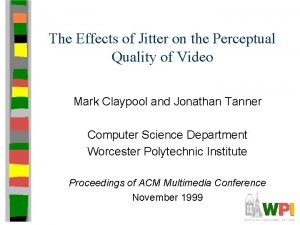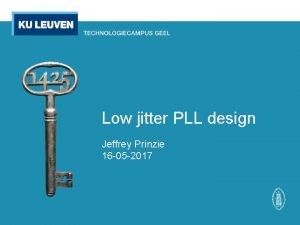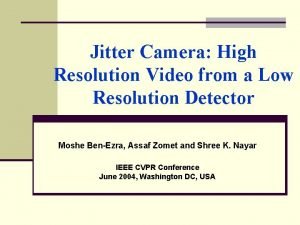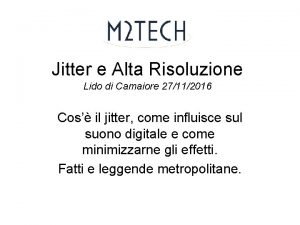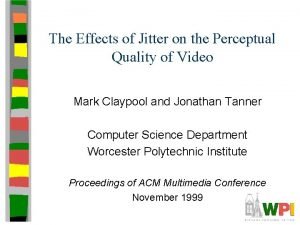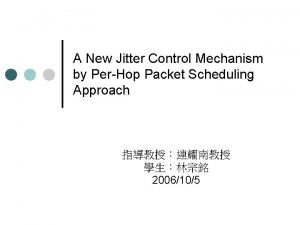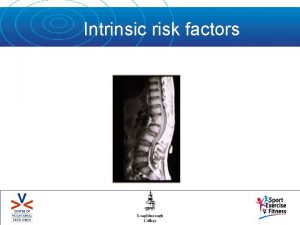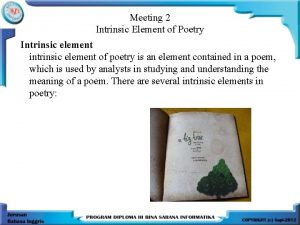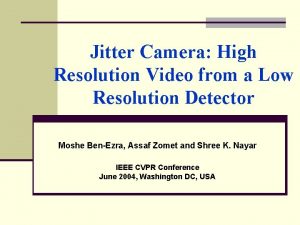Signal formation and intrinsic time resolution Usual Jitter














- Slides: 14

Signal formation and intrinsic time resolution Usual “Jitter” term Here enters everything that is “Noise” and the steepness of Time walk: Amplitude variation, corrected in electronics Shape variations: non homogeneous energy deposition the signal total current Nicolo Cartiglia, INFN, Torino electron current hole current total current electron current Need large d. V/dt hole current 1

How gain shapes the signal Initial electron, holes + - - + Gain electron: absorbed + immediately Gain holes: long drift home Nicolo Cartiglia, INFN, Torino Electrons multiply and produce additional electrons and holes. • Gain electrons have almost no effect • Gain holes dominate the signal No holes multiplications 2

Gain and slew rate vs thickness For a fixed gain: • amplitude = constant • rise time ~ 1/thickness The slew rate: Nicolo Cartiglia, INFN, Torino • Increases with gain • Increases ~ 1/thickness Go thin!! Significant improvements in time resolution require thin detectors 3

Evolution of LGAD signal shape in ETL The signal from an LGAD is short and reaches ~ 10 u. A (gain = 13 in the plot) Gain = 10 Q = 5 f. C Nicolo Cartiglia, INFN, Torino The electronics needs to exploit it: needs to follow the rising edge. 4

Nicolo Cartiglia, INFN, Torino Currents for different thicknesses 5

UFSD time resolution summary Resolution without gain UFSD 1 Nicolo Cartiglia, INFN, Torino UFSD 2 Message: the time resolution is limited by charge non uniformity Be aware: this is not time walk, it is the variability of the current pulse 6

Time resolution at 50 micron Time resolution Nicolo Cartiglia, INFN, Torino Jitter: Not so good electronics Constant term ~ 30 ps Jitter: Very good electronics 5 f. Q 10 f. Q Gain (or charge) Two components determine the time resolution: • Non uniform charge deposition ~ constant term 25 – 30 ps • Jitter contribution = N/(d. V/dt) ~1/Gain (controlled by electronics) 7

UFSD: time resolution UFSD from Hamamatsu confirm our simulation: 30 ps time resolution, Nicolo Cartiglia, INFN, Torino Value of gain ~ 20 8

Weightfield 2 Available at: http: //personalpages. to. infn. it/~cartigli/Weightfield 2/Main. html It requires Root build from source, it is for Linux and Mac. It will not replace TCAD, but it helps in understanding the sensors response Nicolo Cartiglia, INFN, Torino 9

Nicolo Cartiglia, INFN, Torino WF 2: Currents Current tabs 10

WF 2: Electronics Nicolo Cartiglia, INFN, Torino Electronics tabs 11

Nicolo Cartiglia, INFN, Torino WF 2: Radiation damage 12

Evolution of the signal with fluence The UFSD signal becomes • Faster • Shorter • Smaller Nicolo Cartiglia, INFN, Torino Q: 10 f. C 2 f. C Rise time: 400 ps 200 ps Be aware of To. T: the signal tail changes dramatically with irradiation, To. T might not work without constant calibration Use CFD 13

Summary • The signal of UFSD for gain = 10 is 5 f. C The range we need to consider is about 3 – 15 f. C • With 50 -micron thick sensors we have ~ 30 ps intrinsic resolution Nicolo Cartiglia, INFN, Torino • Smaller intrinsic terms require thinner sensors 14

